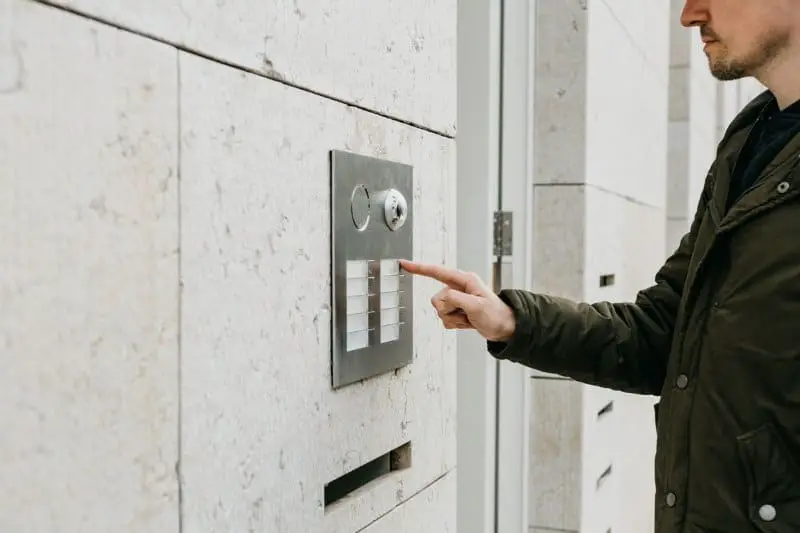Wireless doorbells are easy to install and can be used almost everywhere to alert you that you have someone at the door. If you are installing the wireless doorbell next to other wireless devices, you may wonder if they will be subject to interference from each other. You might specifically wonder, “will my new wireless doorbell interfere with my Wi-Fi?”
Yes, wireless doorbells do interfere with the Wi-Fi signals in and around your home. The doorbells send and receive signals using a frequency similar to that of a Wi-Fi router. As the signals are transmitted from one device to another, they interfere with each other.
In order to understand how this happens, let’s review how a wireless doorbell works. The doorbell has a chime transmitter and a receiver. The doorbell button acts as the transmitter, and it is transmitting wirelessly through waves in the air. No wires connect the button to the chime, but when you press the button, it sends a signal to the chime receiver.
What Happens When You Press the Transmitter Button?
When you press the doorbell button (the transmitter), electrical energy is transmitted through the antenna inside the transmitter. As the signals flow through the wire, electromagnetic waves from the antenna are sent into the air.
The signals sent occupy a certain spectrum of frequency which represent the rate of vibration of the transmitted signals. As the signals circulate the airspace, they can interfere with electromagnetic waves from other Wi-Fi devices before the receiver accepts them.
As the receiver (the chime) receives the signals from the transmitter (the doorbell button), it triggers a series of events which eventually sends an alert or the notification message you have chosen.
The transmitter and receiver communicate with each other through a particular frequency. As the transmitter and receiver establish a connection, each sends signals to the other and they are able to communicate with each other in an efficient and continuous manner.
Long-range wireless doorbells are equipped with a sensitive receiver that can receive signals from a long range, especially if you have a big house. Though this is a good idea when you have a large house, the receivers also pick up signals being transmitted by other wireless devices inside the house. Sometimes they can also pick up signals from your neighbor’s wireless devices if they have a strong enough transmission strength.
If your Wi-Fi router is using the same frequency as the wireless doorbell, the signals transmitted from each of the devices interfere with the operation of the other.
Most wireless devices operate at a frequency band of 2.4 GHz. Some Wi-Fi wireless networks rely on this frequency band to create a Wireless Local Area Network (WLAN) across your home. If your wireless doorbell uses the same frequency to transmit signals, then interference is likely to happen.
There will also be interference from close-by devices that are using the same frequency band. Wireless doorbells together with other wireless devices operate within a particular frequency range. For example, you can have a battery powered doorbell operating at a frequency of 315 MHz to transmit signals from the doorbell button to the receiver. If another device using the same 315 MHz range transmits and receives signals at the same frequency channel as the doorbell, the device signals will interfere with each other.
The more wireless transmitters and wireless electronics you have in your house, the higher the potential of interference. Learn more about doorbell interference from this website.
How Wireless Doorbells Interfere with Your Wi-Fi Network?
In most cases, the internet speed within the house is totally different from the wireless connection speed. This difference is due to a variety of factors that affect the performance of your wireless network.

Signals from your neighbor’s doorbells and Wi-Fi routers also affect your own wireless network transmission devices. Wireless transmitters and receivers such as car alarms and garage door openers can interfere with your wireless doorbell signals.
Instead of blocking the signals when the bell is pressed, they sometimes trigger the bell to ring even when no one has pressed the button.
Channel interference also affects the signal strength of your network. Channel interference occurs when there are multiple wireless devices within the surrounding area and they’re all competing for a position because they share the same channel or frequency band.
In some countries, wireless devices operate within specific channels. For example, in Europe, most wireless devices operate at 2.4 GHz across 13 channels. Some of the channels overlap each other causing a lot of interference. Channels 1, 6, and 11 are the best and most efficient because they do not overlap.
Doorbell devices and any other wireless device operating at 2.4 GHz and using any of the above overlapping channels will slow down the Wi-Fi performance.
Some interference not only affects the performance and signal strength of the Wi-Fi network, it also affects the functioning of the doorbell. For example, the doorbell rings even when not pressed.
If you have issues with your wireless doorbell, look around to see if any other device is using the same frequency as your doorbell. Some of the issues you may face include the doorbell not working, or working partially, and the chime on the receiver going off at random intervals even when no one pressed the button.
Other objects within your house like the fridge, microwave, thick walls and doors weaken the doorbell signal. The more objects in the path of the signal, the weaker the signal becomes from transmission point to receiving point.
How to Reduce Interference
Since the doorbells are generally mounted on the exterior wall of your home, having a thick wall and door between the doorbell and your Wi-Fi router will reduce the level of interference.
The thick walls reduce the strength of the Wi-Fi signal at the front of your house. In most homes, the Wi-Fi network is not optimized to connect to devices located outside your home.
If you want to know the signal strength, you can stand next to your doorbell and test Wi-Fi signals through your mobile phone. Make your connection to the Wi-Fi then use services like speedtest.net or speedof.me to test the signal strength.
An alternative resolution to this problem is to change the frequency of your doorbell to a frequency with less congestion.
If you have modern Wi-Fi routers, they have the capability to scan the channels being used by other wireless devices and select the least crowded channel to broadcast its signals. Make sure to enable this feature on the router. Information on how to enable automatic channel selection can be found in the documentation manual for the router.
If your internet speed is still slow after switching the channel, you can change the channel manually. Afterwards, test the Wi-Fi performance to determine its speed.
You can also upgrade your router to one that uses a frequency band of between 2.4 GHz and 5 GHz. These are faster and less prone to interference compared to old model 2.4 GHz routers.
Changing the Privacy Code to Reduce Interference
Another option to reduce interference is to change the doorbell privacy code. The current wireless doorbells in the market have a privacy code. The privacy code allows you to change the operating frequency of the bell. You can change the privacy code at the back of the transmitting device and also at the back of the doorbell receiving device.
By manually changing the operating frequency signal in the transmitting and receiving doorbell device to, for example, 315.5 MHz, then the chances of another wireless device transmitting at the same frequency is minimal.
Therefore, changing the privacy code of a product changes its operating frequency. If the product has a transmitter and receiving device, then you have to change the privacy code on both devices. Otherwise, the devices will not be able to communicate with each other.
Summary
Wireless doorbells have a chime receiver and transmitter used to send electromagnetic waves. The transmitter sends radio frequency signals inside the house to where the receiver is mounted. If someone presses the button on the transmitter the signal is sent via the transmitter antenna into the air. The receiver issues alerts upon receiving these signals.
Since the signals are transmitted wirelessly using a particular frequency, they can interfere with other signals travelling on the same frequency in the house.
Wi-Fi signals are the most affected since the Wi-Fi router tends to use the same frequency band as those being transmitted by the wireless doorbell.
You can reduce the rate of interference by changing the private code of the doorbell or by changing the channel frequency of your Wi-Fi router. If the two devices are operating at different frequencies, then it will reduce the rate of interference.
Other home appliances can also affect wireless doorbell signals. If the signals that are transmitted pass through a wall, door, fridge or even a microwave, they become weaker. Therefore, when installing the doorbell transmitter and receiver, keep that in mind. Alternatively, you can use different frequencies, which is the most effective way to avoid interference.


